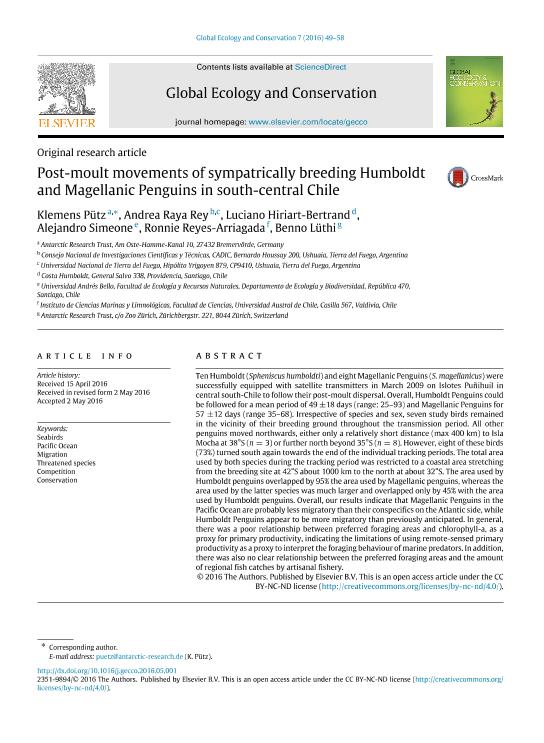Mostrar el registro sencillo del ítem
dc.contributor.author
Pütz, Klemens
dc.contributor.author
Raya Rey, Andrea Nélida

dc.contributor.author
Hiriart Bertrand, Luciano
dc.contributor.author
Simeone, Alejandro
dc.contributor.author
Reyes Arriagada, Ronnie
dc.contributor.author
Lüthi, Benno
dc.date.available
2020-01-14T19:02:51Z
dc.date.issued
2016-07
dc.identifier.citation
Pütz, Klemens; Raya Rey, Andrea Nélida; Hiriart Bertrand, Luciano; Simeone, Alejandro; Reyes Arriagada, Ronnie; et al.; Post-moult movements of sympatrically breeding Humboldt and Magellanic Penguins in south-central Chile; Elsevier; Global Ecology and Conservation; 7; 7-2016; 49-58
dc.identifier.issn
2351-9894
dc.identifier.uri
http://hdl.handle.net/11336/94639
dc.description.abstract
Ten Humboldt (Spheniscus humboldti) and eight Magellanic Penguins (S. magellanicus) were successfully equipped with satellite transmitters in March 2009 on Islotes Puñihuil in central south-Chile to follow their post-moult dispersal. Overall, Humboldt Penguins could be followed for a mean period of 49 ±18 days (range: 25-93) and Magellanic Penguins for 57 ±12 days (range 35-68). Irrespective of species and sex, seven study birds remained in the vicinity of their breeding ground throughout the transmission period. All other penguins moved northwards, either only a relatively short distance (max 400 km) to Isla Mocha at 38°S (n= 3) or further north beyond 35°S (n= 8). However, eight of these birds (73%) turned south again towards the end of the individual tracking periods. The total area used by both species during the tracking period was restricted to a coastal area stretching from the breeding site at 42°S about 1000 km to the north at about 32°S. The area used by Humboldt penguins overlapped by 95% the area used by Magellanic penguins, whereas the area used by the latter species was much larger and overlapped only by 45% with the area used by Humboldt penguins. Overall, our results indicate that Magellanic Penguins in the Pacific Ocean are probably less migratory than their conspecifics on the Atlantic side, while Humboldt Penguins appear to be more migratory than previously anticipated. In general, there was a poor relationship between preferred foraging areas and chlorophyll-a, as a proxy for primary productivity, indicating the limitations of using remote-sensed primary productivity as a proxy to interpret the foraging behaviour of marine predators. In addition, there was also no clear relationship between the preferred foraging areas and the amount of regional fish catches by artisanal fishery.
dc.format
application/pdf
dc.language.iso
eng
dc.publisher
Elsevier

dc.rights
info:eu-repo/semantics/openAccess
dc.rights.uri
https://creativecommons.org/licenses/by-nc-nd/2.5/ar/
dc.subject
COMPETITION
dc.subject
CONSERVATION
dc.subject
MIGRATION
dc.subject
PACIFIC OCEAN
dc.subject
SEABIRDS
dc.subject
THREATENED SPECIES
dc.subject.classification
Ecología

dc.subject.classification
Ciencias Biológicas

dc.subject.classification
CIENCIAS NATURALES Y EXACTAS

dc.title
Post-moult movements of sympatrically breeding Humboldt and Magellanic Penguins in south-central Chile
dc.type
info:eu-repo/semantics/article
dc.type
info:ar-repo/semantics/artículo
dc.type
info:eu-repo/semantics/publishedVersion
dc.date.updated
2020-01-13T14:24:06Z
dc.journal.volume
7
dc.journal.pagination
49-58
dc.journal.pais
Estados Unidos

dc.description.fil
Fil: Pütz, Klemens. Antarctic Research Trust; Alemania
dc.description.fil
Fil: Raya Rey, Andrea Nélida. Consejo Nacional de Investigaciones Científicas y Técnicas. Centro Austral de Investigaciones Científicas; Argentina. Universidad Nacional de Tierra del Fuego; Argentina
dc.description.fil
Fil: Hiriart Bertrand, Luciano. Costa Humboldt; Chile
dc.description.fil
Fil: Simeone, Alejandro. Universidad Andrés Bello; Chile
dc.description.fil
Fil: Reyes Arriagada, Ronnie. Universidad Austral de Chile; Chile
dc.description.fil
Fil: Lüthi, Benno. Antarctic Research Trust; Alemania
dc.journal.title
Global Ecology and Conservation
dc.relation.alternativeid
info:eu-repo/semantics/altIdentifier/doi/http://dx.doi.org/10.1016/j.gecco.2016.05.001
dc.relation.alternativeid
info:eu-repo/semantics/altIdentifier/url/https://www.sciencedirect.com/science/article/pii/S2351989416300415
Archivos asociados
